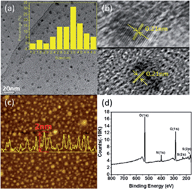Well-controlled layer-by-layer assembly of carbon dot/CdS heterojunctions for efficient visible-light-driven photocatalysis†
Abstract
Fluorescent carbon dots have attracted great attention, but their application in photocatalysis has not been well explored. Herein we report a facile layer-by-layer method to fabricate uniform C dot/CdS heterojunction films via an electrophoretic and sequential chemical bath deposition method. Because no ligands are used, this strategy facilitates the formation of intimate interfacial contact beneficial for charge separation and transfer, which can lead to a high photocurrent density of 2.6 mA cm−2. In addition, the electron donor–acceptor heterojunction can expedite charge separation and effectively suppress electron–hole pair recombination, eventually contributing to enhanced photoelectrochemical and/or photocatalytic efficiency of the system. As a proof-of-concept, the hybrid films manifested themselves as an efficient visible-light-driven photocatalyst when applied for the reduction of nitro-benzene derivatives in the aqueous phase under low power irradiation. Our findings thus establish a new frontier on the rational design and fabrication of well-controlled hybrid films with built-in heterojunctions for solar light conversion.


 Please wait while we load your content...
Please wait while we load your content...